Assignment on Business Law in UK (doc)
VerifiedAdded on 2021/01/02
|16
|5294
|53
AI Summary
Contribute Materials
Your contribution can guide someone’s learning journey. Share your
documents today.

Business Law
Secure Best Marks with AI Grader
Need help grading? Try our AI Grader for instant feedback on your assignments.

Table of Contents
INTRODUCTION ..........................................................................................................................4
LO1..................................................................................................................................................4
P1 Explaining different sources of law in the context of UK ................................................4
P2 Presenting the role of government in making law and how such aspects are applied in
justice court............................................................................................................................5
M1 Evaluating the effectiveness of legal system in terms of recent reforms & developments. .6
LO2 .................................................................................................................................................6
P3 Illustrating the impact of company, employment and contract law on business ..............6
M2 Differentiating legislation, regulations and standards.....................................................6
D1 Critically evaluating legal system and law by using examples........................................6
LO3..................................................................................................................................................6
P4 Explaining manner in which different types of business are legally formed ...................6
P5 Defining how business units are managed and funded.....................................................7
M3 Assessing advantages and disadvantages of different types of organization formed .....8
D2 Critically evaluating types of business unit....................................................................11
LO4................................................................................................................................................12
P6 Recommending legal solutions for resolving range of disputes.....................................12
M4 and D3 Comparing and evaluation varied sources of legal advice associated with dispute
resolution..............................................................................................................................12
CONCLUSION..............................................................................................................................13
REFERENCES..............................................................................................................................14
INTRODUCTION ..........................................................................................................................4
LO1..................................................................................................................................................4
P1 Explaining different sources of law in the context of UK ................................................4
P2 Presenting the role of government in making law and how such aspects are applied in
justice court............................................................................................................................5
M1 Evaluating the effectiveness of legal system in terms of recent reforms & developments. .6
LO2 .................................................................................................................................................6
P3 Illustrating the impact of company, employment and contract law on business ..............6
M2 Differentiating legislation, regulations and standards.....................................................6
D1 Critically evaluating legal system and law by using examples........................................6
LO3..................................................................................................................................................6
P4 Explaining manner in which different types of business are legally formed ...................6
P5 Defining how business units are managed and funded.....................................................7
M3 Assessing advantages and disadvantages of different types of organization formed .....8
D2 Critically evaluating types of business unit....................................................................11
LO4................................................................................................................................................12
P6 Recommending legal solutions for resolving range of disputes.....................................12
M4 and D3 Comparing and evaluation varied sources of legal advice associated with dispute
resolution..............................................................................................................................12
CONCLUSION..............................................................................................................................13
REFERENCES..............................................................................................................................14
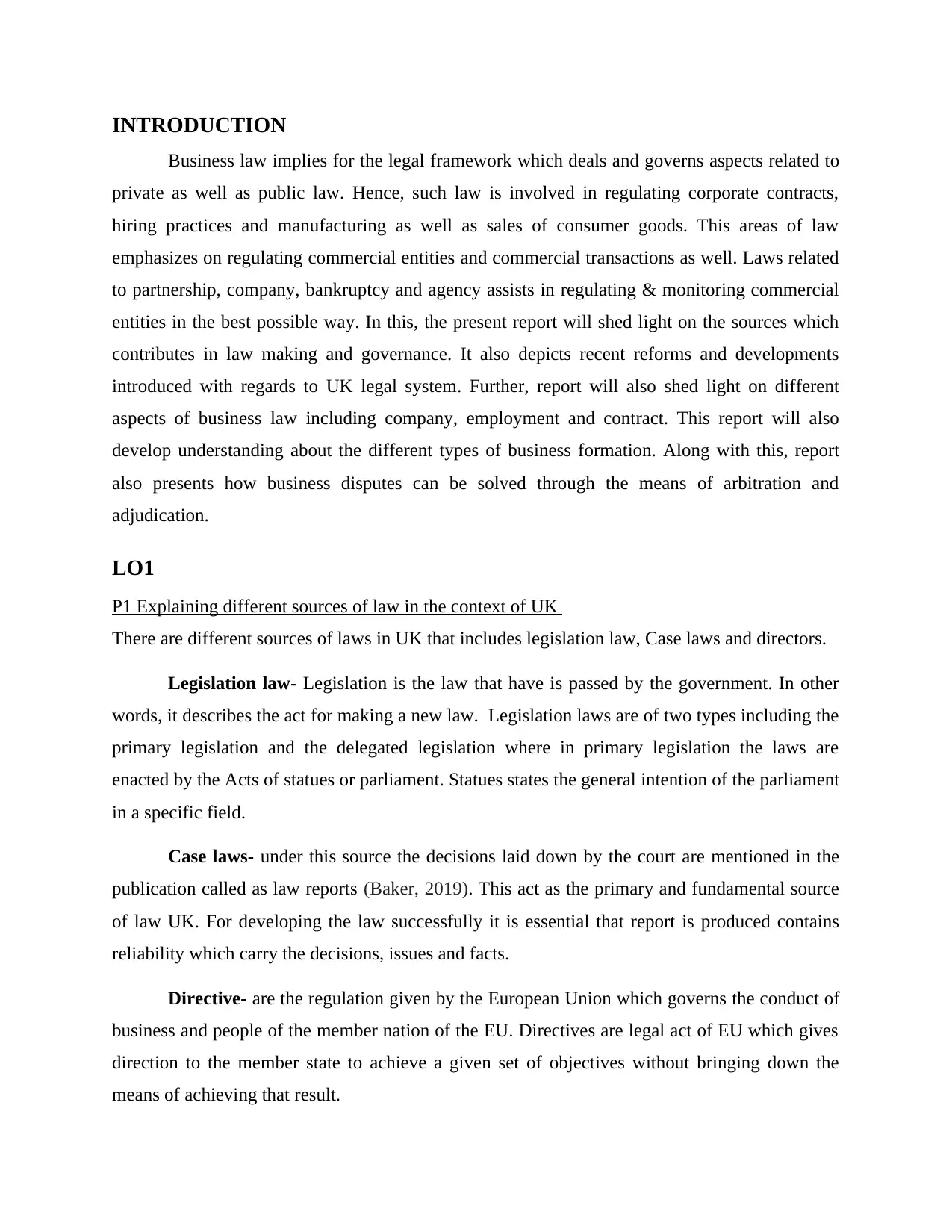
INTRODUCTION
Business law implies for the legal framework which deals and governs aspects related to
private as well as public law. Hence, such law is involved in regulating corporate contracts,
hiring practices and manufacturing as well as sales of consumer goods. This areas of law
emphasizes on regulating commercial entities and commercial transactions as well. Laws related
to partnership, company, bankruptcy and agency assists in regulating & monitoring commercial
entities in the best possible way. In this, the present report will shed light on the sources which
contributes in law making and governance. It also depicts recent reforms and developments
introduced with regards to UK legal system. Further, report will also shed light on different
aspects of business law including company, employment and contract. This report will also
develop understanding about the different types of business formation. Along with this, report
also presents how business disputes can be solved through the means of arbitration and
adjudication.
LO1
P1 Explaining different sources of law in the context of UK
There are different sources of laws in UK that includes legislation law, Case laws and directors.
Legislation law- Legislation is the law that have is passed by the government. In other
words, it describes the act for making a new law. Legislation laws are of two types including the
primary legislation and the delegated legislation where in primary legislation the laws are
enacted by the Acts of statues or parliament. Statues states the general intention of the parliament
in a specific field.
Case laws- under this source the decisions laid down by the court are mentioned in the
publication called as law reports (Baker, 2019). This act as the primary and fundamental source
of law UK. For developing the law successfully it is essential that report is produced contains
reliability which carry the decisions, issues and facts.
Directive- are the regulation given by the European Union which governs the conduct of
business and people of the member nation of the EU. Directives are legal act of EU which gives
direction to the member state to achieve a given set of objectives without bringing down the
means of achieving that result.
Business law implies for the legal framework which deals and governs aspects related to
private as well as public law. Hence, such law is involved in regulating corporate contracts,
hiring practices and manufacturing as well as sales of consumer goods. This areas of law
emphasizes on regulating commercial entities and commercial transactions as well. Laws related
to partnership, company, bankruptcy and agency assists in regulating & monitoring commercial
entities in the best possible way. In this, the present report will shed light on the sources which
contributes in law making and governance. It also depicts recent reforms and developments
introduced with regards to UK legal system. Further, report will also shed light on different
aspects of business law including company, employment and contract. This report will also
develop understanding about the different types of business formation. Along with this, report
also presents how business disputes can be solved through the means of arbitration and
adjudication.
LO1
P1 Explaining different sources of law in the context of UK
There are different sources of laws in UK that includes legislation law, Case laws and directors.
Legislation law- Legislation is the law that have is passed by the government. In other
words, it describes the act for making a new law. Legislation laws are of two types including the
primary legislation and the delegated legislation where in primary legislation the laws are
enacted by the Acts of statues or parliament. Statues states the general intention of the parliament
in a specific field.
Case laws- under this source the decisions laid down by the court are mentioned in the
publication called as law reports (Baker, 2019). This act as the primary and fundamental source
of law UK. For developing the law successfully it is essential that report is produced contains
reliability which carry the decisions, issues and facts.
Directive- are the regulation given by the European Union which governs the conduct of
business and people of the member nation of the EU. Directives are legal act of EU which gives
direction to the member state to achieve a given set of objectives without bringing down the
means of achieving that result.
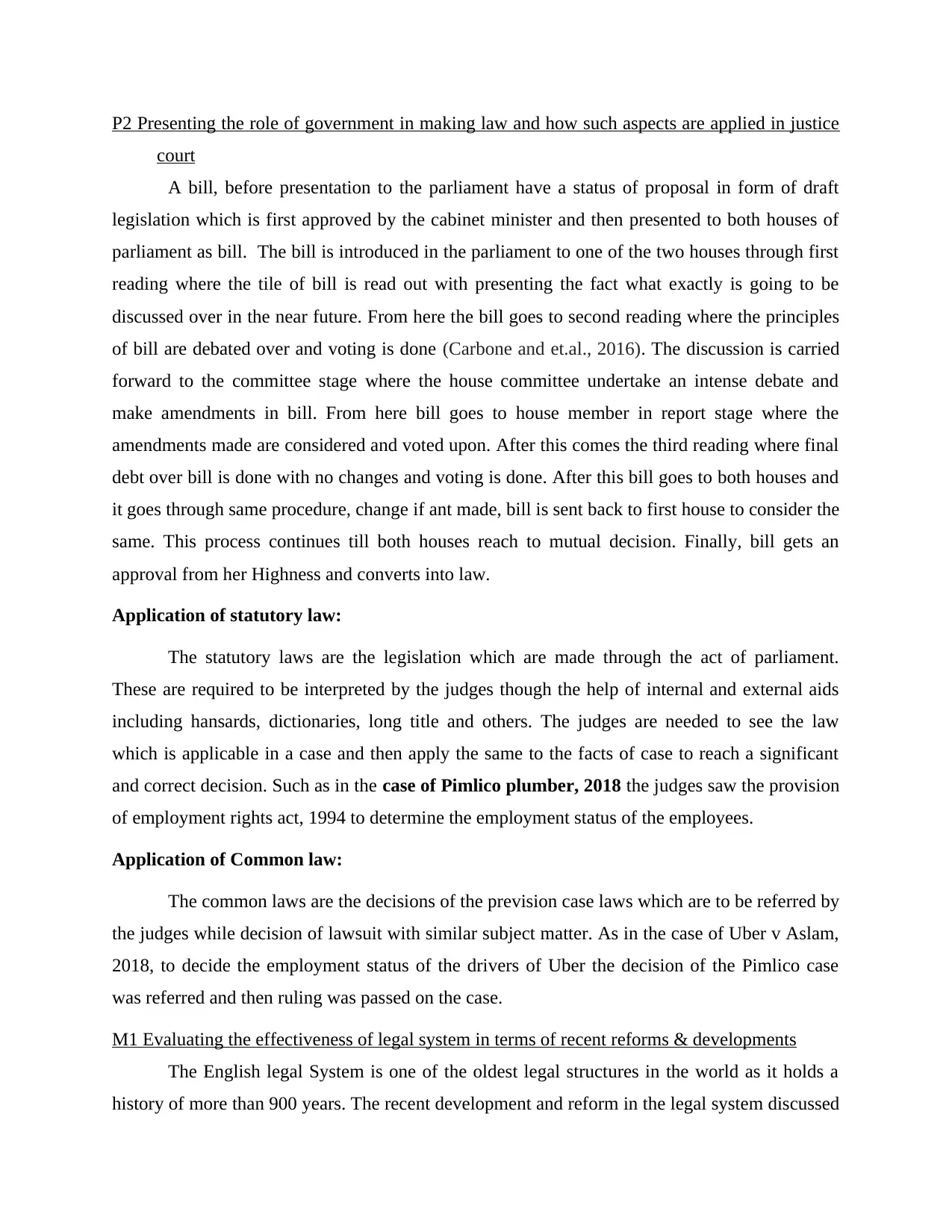
P2 Presenting the role of government in making law and how such aspects are applied in justice
court
A bill, before presentation to the parliament have a status of proposal in form of draft
legislation which is first approved by the cabinet minister and then presented to both houses of
parliament as bill. The bill is introduced in the parliament to one of the two houses through first
reading where the tile of bill is read out with presenting the fact what exactly is going to be
discussed over in the near future. From here the bill goes to second reading where the principles
of bill are debated over and voting is done (Carbone and et.al., 2016). The discussion is carried
forward to the committee stage where the house committee undertake an intense debate and
make amendments in bill. From here bill goes to house member in report stage where the
amendments made are considered and voted upon. After this comes the third reading where final
debt over bill is done with no changes and voting is done. After this bill goes to both houses and
it goes through same procedure, change if ant made, bill is sent back to first house to consider the
same. This process continues till both houses reach to mutual decision. Finally, bill gets an
approval from her Highness and converts into law.
Application of statutory law:
The statutory laws are the legislation which are made through the act of parliament.
These are required to be interpreted by the judges though the help of internal and external aids
including hansards, dictionaries, long title and others. The judges are needed to see the law
which is applicable in a case and then apply the same to the facts of case to reach a significant
and correct decision. Such as in the case of Pimlico plumber, 2018 the judges saw the provision
of employment rights act, 1994 to determine the employment status of the employees.
Application of Common law:
The common laws are the decisions of the prevision case laws which are to be referred by
the judges while decision of lawsuit with similar subject matter. As in the case of Uber v Aslam,
2018, to decide the employment status of the drivers of Uber the decision of the Pimlico case
was referred and then ruling was passed on the case.
M1 Evaluating the effectiveness of legal system in terms of recent reforms & developments
The English legal System is one of the oldest legal structures in the world as it holds a
history of more than 900 years. The recent development and reform in the legal system discussed
court
A bill, before presentation to the parliament have a status of proposal in form of draft
legislation which is first approved by the cabinet minister and then presented to both houses of
parliament as bill. The bill is introduced in the parliament to one of the two houses through first
reading where the tile of bill is read out with presenting the fact what exactly is going to be
discussed over in the near future. From here the bill goes to second reading where the principles
of bill are debated over and voting is done (Carbone and et.al., 2016). The discussion is carried
forward to the committee stage where the house committee undertake an intense debate and
make amendments in bill. From here bill goes to house member in report stage where the
amendments made are considered and voted upon. After this comes the third reading where final
debt over bill is done with no changes and voting is done. After this bill goes to both houses and
it goes through same procedure, change if ant made, bill is sent back to first house to consider the
same. This process continues till both houses reach to mutual decision. Finally, bill gets an
approval from her Highness and converts into law.
Application of statutory law:
The statutory laws are the legislation which are made through the act of parliament.
These are required to be interpreted by the judges though the help of internal and external aids
including hansards, dictionaries, long title and others. The judges are needed to see the law
which is applicable in a case and then apply the same to the facts of case to reach a significant
and correct decision. Such as in the case of Pimlico plumber, 2018 the judges saw the provision
of employment rights act, 1994 to determine the employment status of the employees.
Application of Common law:
The common laws are the decisions of the prevision case laws which are to be referred by
the judges while decision of lawsuit with similar subject matter. As in the case of Uber v Aslam,
2018, to decide the employment status of the drivers of Uber the decision of the Pimlico case
was referred and then ruling was passed on the case.
M1 Evaluating the effectiveness of legal system in terms of recent reforms & developments
The English legal System is one of the oldest legal structures in the world as it holds a
history of more than 900 years. The recent development and reform in the legal system discussed
Paraphrase This Document
Need a fresh take? Get an instant paraphrase of this document with our AI Paraphraser

in this present question is done for last 10 years from 2008. This includes changes in the form of
court justice, structure and formation of the new laws and legislation with abolition of some.
There was major change in the justice court in 2009 where supreme court was formed and all the
powers from house of lords were taken (United Kingdom Law: Law reform, 2018). The tribunal
services were merged with the court services in 2011. In 2012 the college of policing was created
along with replacement of local police authorities with elected police and crime commissioner.
In 2014 new probation services was created with abolishing the of public sector probation
services. From 2017 major shift was seen in the technique of solving the disputes. The trade
union have been more inclined to the arbitration method of solving the employment disputes
rather than going to the court for litigation. These changes in the justice court, police structure
and dispute resolution have transformed the perspective of the English legal system.
LO2
P3 Illustrating the impact of company, employment and contract law on business
Employment law: includes many laws pertaining to the employment which are Equality
act, 2010, employment rights act 1996, health and safety act, 1974 and others. All the laws
defines certain duties and responsibilities of the employer towards their employees. A failure to
comply with this can lead to sever legal consequences which includes fines, penalties and
imprisonment.
As in the case of Lee V Ashers Baking Co Ltd and others it was held by the supreme court that a
person have every right to refuse to work under the employment of an employer who is refusing
to work due to the sexuate orientation of a worker.
Contract law: defines rights and obligation of parties under a written or oral agreement.
This guides the conduct of the parties that they are obliged to perform what is specified and has
been promise (de Gioia-Carabellese and Sangiorgio, 2016) . If not done, it is referred as breach
and the organisation under breach might face significant legal consequences of the same in the
form of completing what is being promised composition of damages suffered or imprisonment.
For example: in the case of Hochster v De la Tour (1853) 2 E & B 678 it was held that when a
party do not communicate their intention of non performance of contract the innocent party is
court justice, structure and formation of the new laws and legislation with abolition of some.
There was major change in the justice court in 2009 where supreme court was formed and all the
powers from house of lords were taken (United Kingdom Law: Law reform, 2018). The tribunal
services were merged with the court services in 2011. In 2012 the college of policing was created
along with replacement of local police authorities with elected police and crime commissioner.
In 2014 new probation services was created with abolishing the of public sector probation
services. From 2017 major shift was seen in the technique of solving the disputes. The trade
union have been more inclined to the arbitration method of solving the employment disputes
rather than going to the court for litigation. These changes in the justice court, police structure
and dispute resolution have transformed the perspective of the English legal system.
LO2
P3 Illustrating the impact of company, employment and contract law on business
Employment law: includes many laws pertaining to the employment which are Equality
act, 2010, employment rights act 1996, health and safety act, 1974 and others. All the laws
defines certain duties and responsibilities of the employer towards their employees. A failure to
comply with this can lead to sever legal consequences which includes fines, penalties and
imprisonment.
As in the case of Lee V Ashers Baking Co Ltd and others it was held by the supreme court that a
person have every right to refuse to work under the employment of an employer who is refusing
to work due to the sexuate orientation of a worker.
Contract law: defines rights and obligation of parties under a written or oral agreement.
This guides the conduct of the parties that they are obliged to perform what is specified and has
been promise (de Gioia-Carabellese and Sangiorgio, 2016) . If not done, it is referred as breach
and the organisation under breach might face significant legal consequences of the same in the
form of completing what is being promised composition of damages suffered or imprisonment.
For example: in the case of Hochster v De la Tour (1853) 2 E & B 678 it was held that when a
party do not communicate their intention of non performance of contract the innocent party is
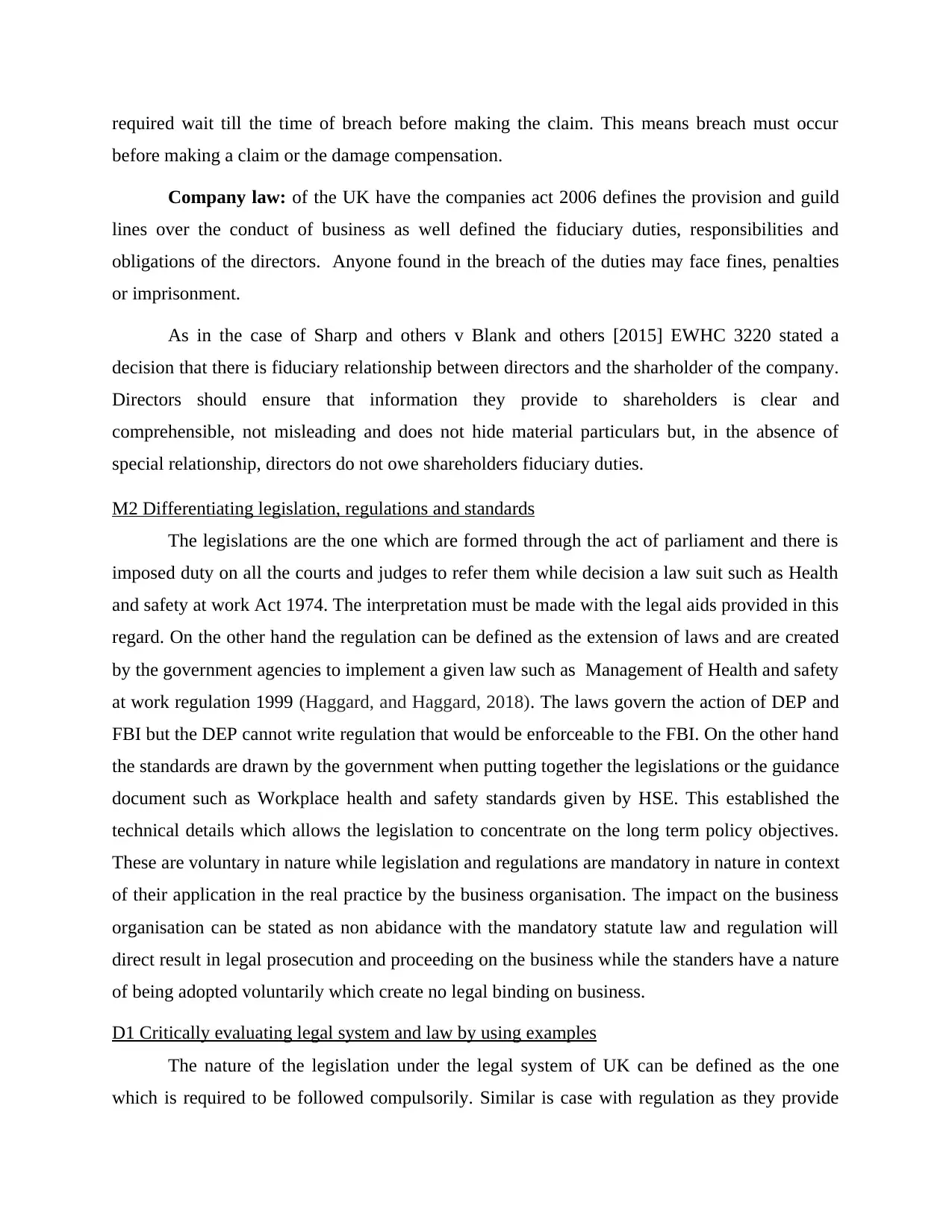
required wait till the time of breach before making the claim. This means breach must occur
before making a claim or the damage compensation.
Company law: of the UK have the companies act 2006 defines the provision and guild
lines over the conduct of business as well defined the fiduciary duties, responsibilities and
obligations of the directors. Anyone found in the breach of the duties may face fines, penalties
or imprisonment.
As in the case of Sharp and others v Blank and others [2015] EWHC 3220 stated a
decision that there is fiduciary relationship between directors and the sharholder of the company.
Directors should ensure that information they provide to shareholders is clear and
comprehensible, not misleading and does not hide material particulars but, in the absence of
special relationship, directors do not owe shareholders fiduciary duties.
M2 Differentiating legislation, regulations and standards
The legislations are the one which are formed through the act of parliament and there is
imposed duty on all the courts and judges to refer them while decision a law suit such as Health
and safety at work Act 1974. The interpretation must be made with the legal aids provided in this
regard. On the other hand the regulation can be defined as the extension of laws and are created
by the government agencies to implement a given law such as Management of Health and safety
at work regulation 1999 (Haggard, and Haggard, 2018). The laws govern the action of DEP and
FBI but the DEP cannot write regulation that would be enforceable to the FBI. On the other hand
the standards are drawn by the government when putting together the legislations or the guidance
document such as Workplace health and safety standards given by HSE. This established the
technical details which allows the legislation to concentrate on the long term policy objectives.
These are voluntary in nature while legislation and regulations are mandatory in nature in context
of their application in the real practice by the business organisation. The impact on the business
organisation can be stated as non abidance with the mandatory statute law and regulation will
direct result in legal prosecution and proceeding on the business while the standers have a nature
of being adopted voluntarily which create no legal binding on business.
D1 Critically evaluating legal system and law by using examples
The nature of the legislation under the legal system of UK can be defined as the one
which is required to be followed compulsorily. Similar is case with regulation as they provide
before making a claim or the damage compensation.
Company law: of the UK have the companies act 2006 defines the provision and guild
lines over the conduct of business as well defined the fiduciary duties, responsibilities and
obligations of the directors. Anyone found in the breach of the duties may face fines, penalties
or imprisonment.
As in the case of Sharp and others v Blank and others [2015] EWHC 3220 stated a
decision that there is fiduciary relationship between directors and the sharholder of the company.
Directors should ensure that information they provide to shareholders is clear and
comprehensible, not misleading and does not hide material particulars but, in the absence of
special relationship, directors do not owe shareholders fiduciary duties.
M2 Differentiating legislation, regulations and standards
The legislations are the one which are formed through the act of parliament and there is
imposed duty on all the courts and judges to refer them while decision a law suit such as Health
and safety at work Act 1974. The interpretation must be made with the legal aids provided in this
regard. On the other hand the regulation can be defined as the extension of laws and are created
by the government agencies to implement a given law such as Management of Health and safety
at work regulation 1999 (Haggard, and Haggard, 2018). The laws govern the action of DEP and
FBI but the DEP cannot write regulation that would be enforceable to the FBI. On the other hand
the standards are drawn by the government when putting together the legislations or the guidance
document such as Workplace health and safety standards given by HSE. This established the
technical details which allows the legislation to concentrate on the long term policy objectives.
These are voluntary in nature while legislation and regulations are mandatory in nature in context
of their application in the real practice by the business organisation. The impact on the business
organisation can be stated as non abidance with the mandatory statute law and regulation will
direct result in legal prosecution and proceeding on the business while the standers have a nature
of being adopted voluntarily which create no legal binding on business.
D1 Critically evaluating legal system and law by using examples
The nature of the legislation under the legal system of UK can be defined as the one
which is required to be followed compulsorily. Similar is case with regulation as they provide
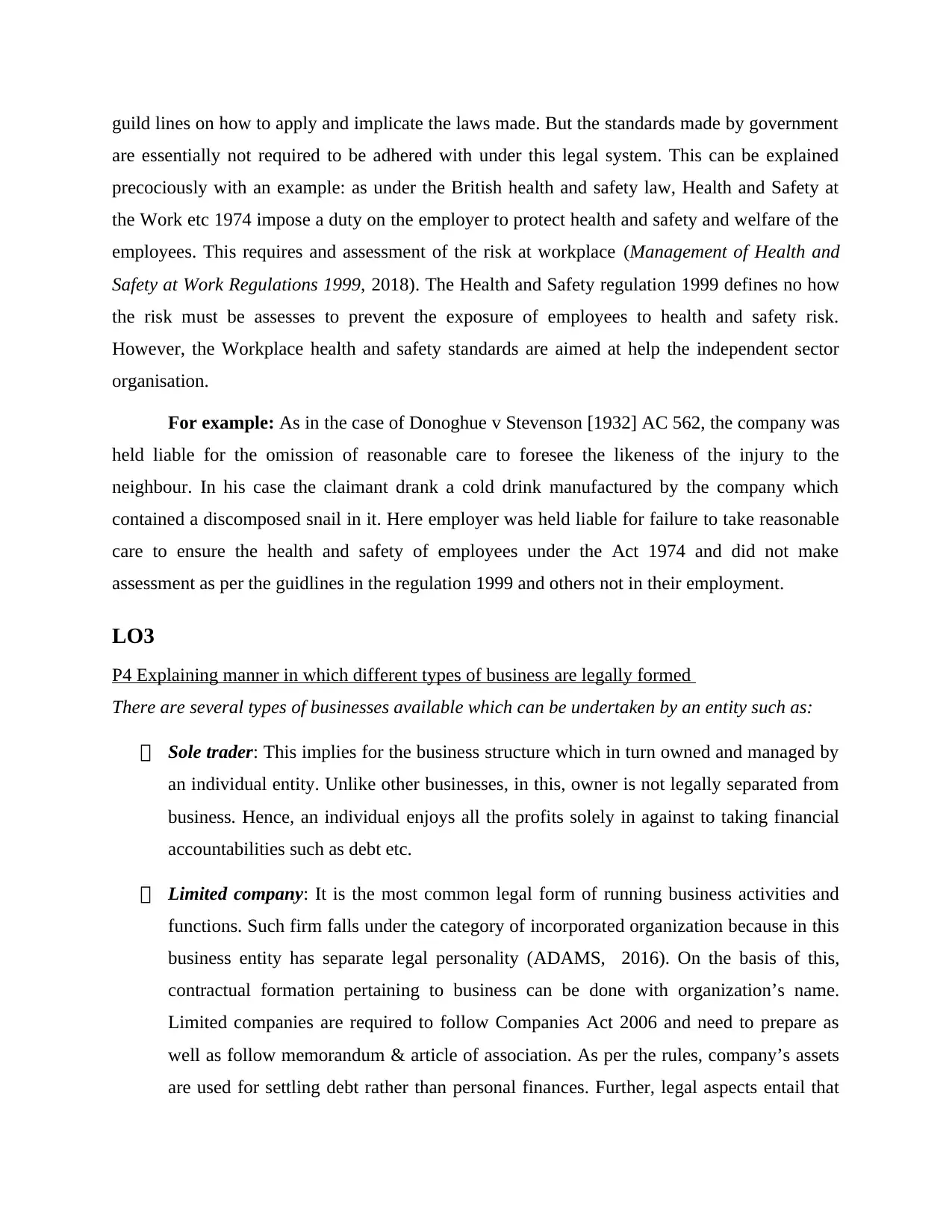
guild lines on how to apply and implicate the laws made. But the standards made by government
are essentially not required to be adhered with under this legal system. This can be explained
precociously with an example: as under the British health and safety law, Health and Safety at
the Work etc 1974 impose a duty on the employer to protect health and safety and welfare of the
employees. This requires and assessment of the risk at workplace (Management of Health and
Safety at Work Regulations 1999, 2018). The Health and Safety regulation 1999 defines no how
the risk must be assesses to prevent the exposure of employees to health and safety risk.
However, the Workplace health and safety standards are aimed at help the independent sector
organisation.
For example: As in the case of Donoghue v Stevenson [1932] AC 562, the company was
held liable for the omission of reasonable care to foresee the likeness of the injury to the
neighbour. In his case the claimant drank a cold drink manufactured by the company which
contained a discomposed snail in it. Here employer was held liable for failure to take reasonable
care to ensure the health and safety of employees under the Act 1974 and did not make
assessment as per the guidlines in the regulation 1999 and others not in their employment.
LO3
P4 Explaining manner in which different types of business are legally formed
There are several types of businesses available which can be undertaken by an entity such as:
Sole trader: This implies for the business structure which in turn owned and managed by
an individual entity. Unlike other businesses, in this, owner is not legally separated from
business. Hence, an individual enjoys all the profits solely in against to taking financial
accountabilities such as debt etc.
Limited company: It is the most common legal form of running business activities and
functions. Such firm falls under the category of incorporated organization because in this
business entity has separate legal personality (ADAMS, 2016). On the basis of this,
contractual formation pertaining to business can be done with organization’s name.
Limited companies are required to follow Companies Act 2006 and need to prepare as
well as follow memorandum & article of association. As per the rules, company’s assets
are used for settling debt rather than personal finances. Further, legal aspects entail that
are essentially not required to be adhered with under this legal system. This can be explained
precociously with an example: as under the British health and safety law, Health and Safety at
the Work etc 1974 impose a duty on the employer to protect health and safety and welfare of the
employees. This requires and assessment of the risk at workplace (Management of Health and
Safety at Work Regulations 1999, 2018). The Health and Safety regulation 1999 defines no how
the risk must be assesses to prevent the exposure of employees to health and safety risk.
However, the Workplace health and safety standards are aimed at help the independent sector
organisation.
For example: As in the case of Donoghue v Stevenson [1932] AC 562, the company was
held liable for the omission of reasonable care to foresee the likeness of the injury to the
neighbour. In his case the claimant drank a cold drink manufactured by the company which
contained a discomposed snail in it. Here employer was held liable for failure to take reasonable
care to ensure the health and safety of employees under the Act 1974 and did not make
assessment as per the guidlines in the regulation 1999 and others not in their employment.
LO3
P4 Explaining manner in which different types of business are legally formed
There are several types of businesses available which can be undertaken by an entity such as:
Sole trader: This implies for the business structure which in turn owned and managed by
an individual entity. Unlike other businesses, in this, owner is not legally separated from
business. Hence, an individual enjoys all the profits solely in against to taking financial
accountabilities such as debt etc.
Limited company: It is the most common legal form of running business activities and
functions. Such firm falls under the category of incorporated organization because in this
business entity has separate legal personality (ADAMS, 2016). On the basis of this,
contractual formation pertaining to business can be done with organization’s name.
Limited companies are required to follow Companies Act 2006 and need to prepare as
well as follow memorandum & article of association. As per the rules, company’s assets
are used for settling debt rather than personal finances. Further, legal aspects entail that
Secure Best Marks with AI Grader
Need help grading? Try our AI Grader for instant feedback on your assignments.

firm must have at least one member. Along with this, if business unit has taxable profit
then HMRC needs to be communicated that it is liable for paying corporation tax.
Partnership: It is relatively a way for the two or more than two persons for running the
business together with objective of earning profit. Partnership does not require any kind
of formal agreement, it only needs to prepare a partnership deed to carry on the business
in a common direction (Menkel-Meadow, 2015). The partnership deed or agreement are
legally binding on the partners and sets out matters including the amount of capital
invested by each of the partner and the method of proportion in which the profits will be
shared between them. Partnership is not considered as the separate legal entity. All the
risks, responsibilities and costs are shared among the partners for being in the business.
P5 Defining how business units are managed and funded
Sole traders- Sole proprietorships are simple to start and manage, they begin with the
host of financial, business and legal risks associated in the business. Raising the fund is a
difficult task for the sole trader because they cannot offer or issue shares as like big corporation
or having partners for obtaining the capital. However, several options are available to them like
self-owned money, seeking the funds from friends and family. Other options for funding
available to the sole proprietor are bank loan, venture capital loan from the investors etc. The
primary managerial function of a sole proprietor is establishing the business including filing the
paperwork with state and district authorities (ELLIOTT and QUINN, 2015). For forming the sole
proprietor business unit, a sole trader only require to register his name with the clerk of the
country.
Limited Company- For managing the structure of limited corporation, more complexities
are involved. The management of limited company is in the hands of Boards of directors called
as the officers of the company. The management also involves the members and the shareholders
who act as the owners of the entity. Limited company obtain their finances through various
sources such as internal sources, external sources and banks. Internal sources of funding involves
the funds raised from shareholders person savings, grants from friends and family etc. at an
initial level. Moreover, when the firm is earning profits and reaches the expanding stage, funds
can be attained by re-investing the profits rather than distributing as a dividend to the
shareholders. This internal source of financing can be used for smooth running of the operations.
then HMRC needs to be communicated that it is liable for paying corporation tax.
Partnership: It is relatively a way for the two or more than two persons for running the
business together with objective of earning profit. Partnership does not require any kind
of formal agreement, it only needs to prepare a partnership deed to carry on the business
in a common direction (Menkel-Meadow, 2015). The partnership deed or agreement are
legally binding on the partners and sets out matters including the amount of capital
invested by each of the partner and the method of proportion in which the profits will be
shared between them. Partnership is not considered as the separate legal entity. All the
risks, responsibilities and costs are shared among the partners for being in the business.
P5 Defining how business units are managed and funded
Sole traders- Sole proprietorships are simple to start and manage, they begin with the
host of financial, business and legal risks associated in the business. Raising the fund is a
difficult task for the sole trader because they cannot offer or issue shares as like big corporation
or having partners for obtaining the capital. However, several options are available to them like
self-owned money, seeking the funds from friends and family. Other options for funding
available to the sole proprietor are bank loan, venture capital loan from the investors etc. The
primary managerial function of a sole proprietor is establishing the business including filing the
paperwork with state and district authorities (ELLIOTT and QUINN, 2015). For forming the sole
proprietor business unit, a sole trader only require to register his name with the clerk of the
country.
Limited Company- For managing the structure of limited corporation, more complexities
are involved. The management of limited company is in the hands of Boards of directors called
as the officers of the company. The management also involves the members and the shareholders
who act as the owners of the entity. Limited company obtain their finances through various
sources such as internal sources, external sources and banks. Internal sources of funding involves
the funds raised from shareholders person savings, grants from friends and family etc. at an
initial level. Moreover, when the firm is earning profits and reaches the expanding stage, funds
can be attained by re-investing the profits rather than distributing as a dividend to the
shareholders. This internal source of financing can be used for smooth running of the operations.
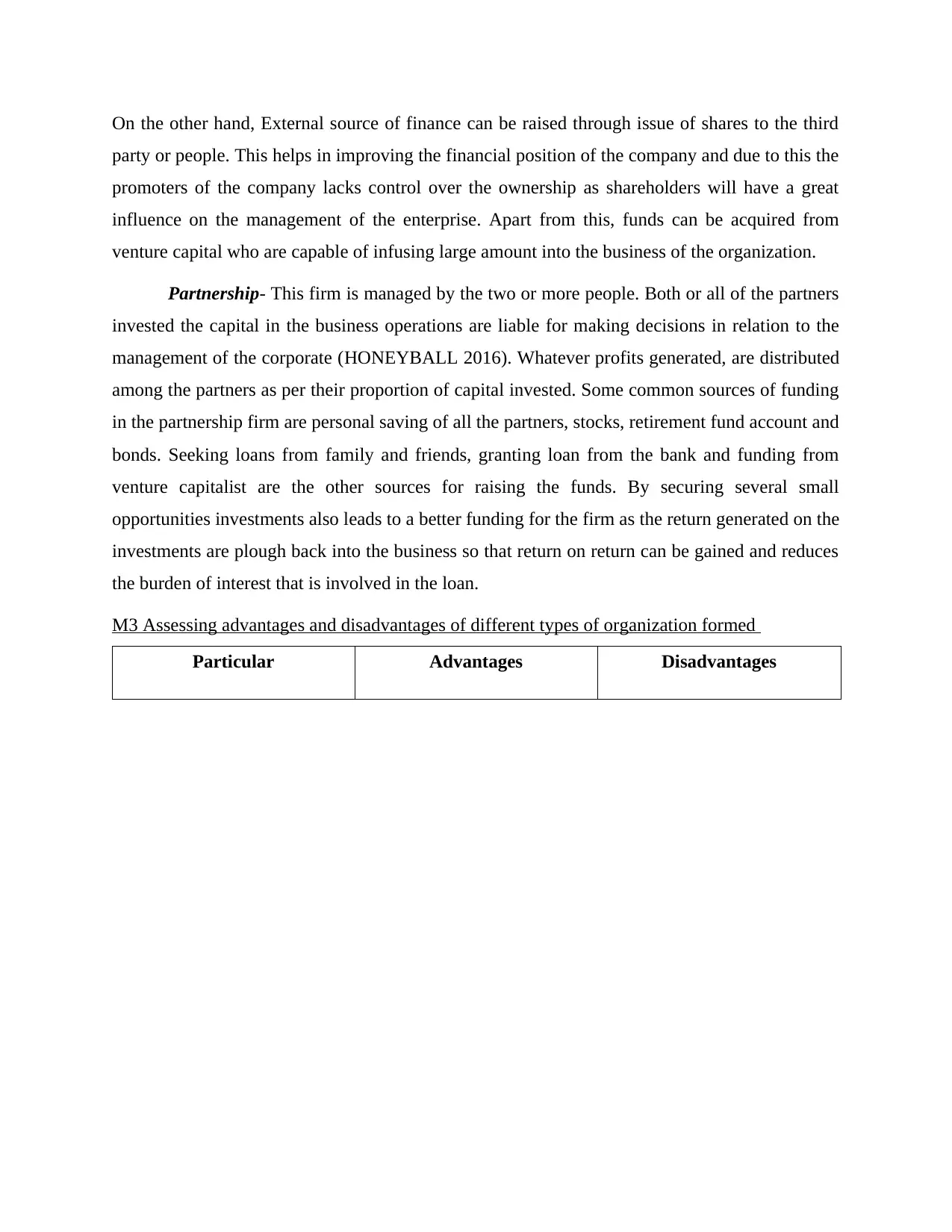
On the other hand, External source of finance can be raised through issue of shares to the third
party or people. This helps in improving the financial position of the company and due to this the
promoters of the company lacks control over the ownership as shareholders will have a great
influence on the management of the enterprise. Apart from this, funds can be acquired from
venture capital who are capable of infusing large amount into the business of the organization.
Partnership- This firm is managed by the two or more people. Both or all of the partners
invested the capital in the business operations are liable for making decisions in relation to the
management of the corporate (HONEYBALL 2016). Whatever profits generated, are distributed
among the partners as per their proportion of capital invested. Some common sources of funding
in the partnership firm are personal saving of all the partners, stocks, retirement fund account and
bonds. Seeking loans from family and friends, granting loan from the bank and funding from
venture capitalist are the other sources for raising the funds. By securing several small
opportunities investments also leads to a better funding for the firm as the return generated on the
investments are plough back into the business so that return on return can be gained and reduces
the burden of interest that is involved in the loan.
M3 Assessing advantages and disadvantages of different types of organization formed
Particular Advantages Disadvantages
party or people. This helps in improving the financial position of the company and due to this the
promoters of the company lacks control over the ownership as shareholders will have a great
influence on the management of the enterprise. Apart from this, funds can be acquired from
venture capital who are capable of infusing large amount into the business of the organization.
Partnership- This firm is managed by the two or more people. Both or all of the partners
invested the capital in the business operations are liable for making decisions in relation to the
management of the corporate (HONEYBALL 2016). Whatever profits generated, are distributed
among the partners as per their proportion of capital invested. Some common sources of funding
in the partnership firm are personal saving of all the partners, stocks, retirement fund account and
bonds. Seeking loans from family and friends, granting loan from the bank and funding from
venture capitalist are the other sources for raising the funds. By securing several small
opportunities investments also leads to a better funding for the firm as the return generated on the
investments are plough back into the business so that return on return can be gained and reduces
the burden of interest that is involved in the loan.
M3 Assessing advantages and disadvantages of different types of organization formed
Particular Advantages Disadvantages
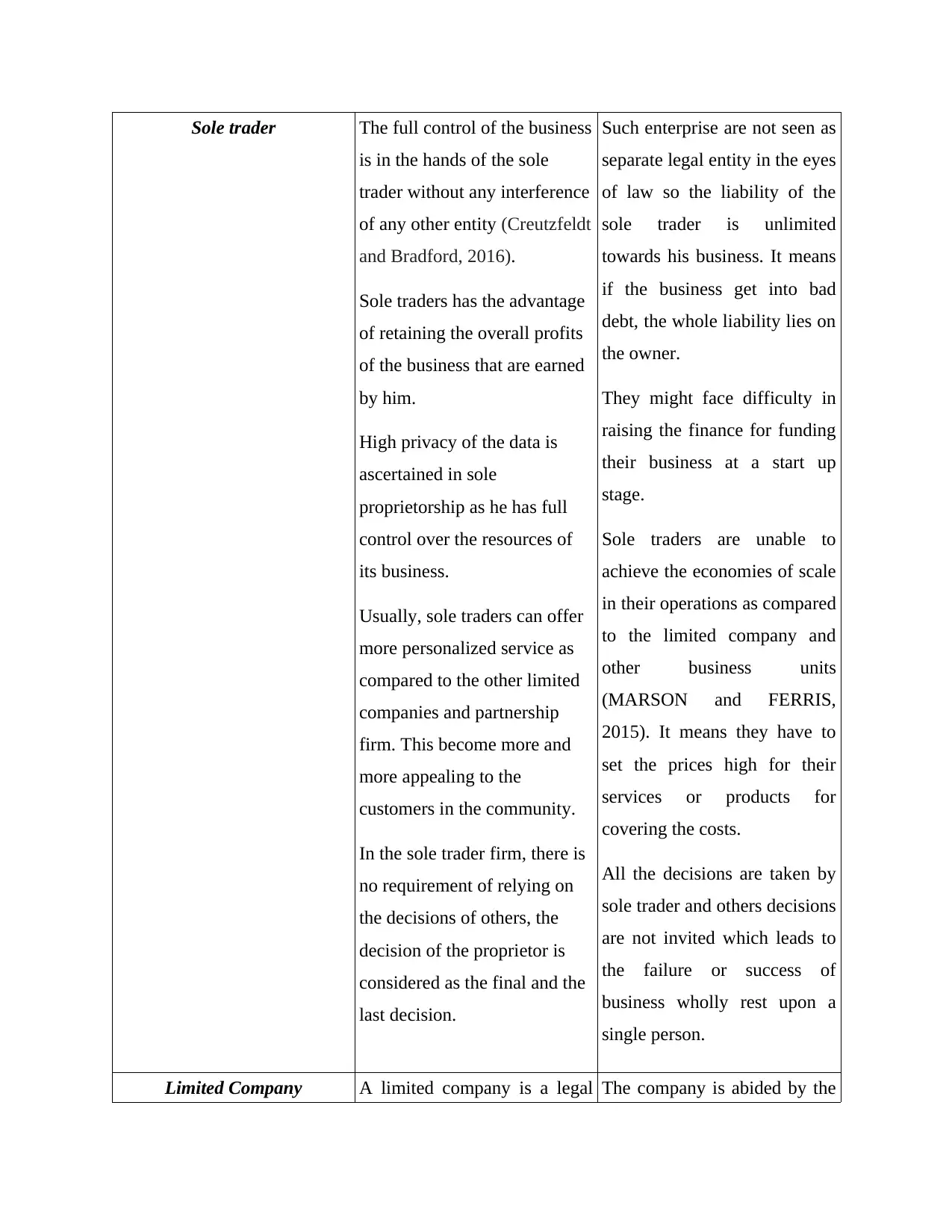
Sole trader The full control of the business
is in the hands of the sole
trader without any interference
of any other entity (Creutzfeldt
and Bradford, 2016).
Sole traders has the advantage
of retaining the overall profits
of the business that are earned
by him.
High privacy of the data is
ascertained in sole
proprietorship as he has full
control over the resources of
its business.
Usually, sole traders can offer
more personalized service as
compared to the other limited
companies and partnership
firm. This become more and
more appealing to the
customers in the community.
In the sole trader firm, there is
no requirement of relying on
the decisions of others, the
decision of the proprietor is
considered as the final and the
last decision.
Such enterprise are not seen as
separate legal entity in the eyes
of law so the liability of the
sole trader is unlimited
towards his business. It means
if the business get into bad
debt, the whole liability lies on
the owner.
They might face difficulty in
raising the finance for funding
their business at a start up
stage.
Sole traders are unable to
achieve the economies of scale
in their operations as compared
to the limited company and
other business units
(MARSON and FERRIS,
2015). It means they have to
set the prices high for their
services or products for
covering the costs.
All the decisions are taken by
sole trader and others decisions
are not invited which leads to
the failure or success of
business wholly rest upon a
single person.
Limited Company A limited company is a legal The company is abided by the
is in the hands of the sole
trader without any interference
of any other entity (Creutzfeldt
and Bradford, 2016).
Sole traders has the advantage
of retaining the overall profits
of the business that are earned
by him.
High privacy of the data is
ascertained in sole
proprietorship as he has full
control over the resources of
its business.
Usually, sole traders can offer
more personalized service as
compared to the other limited
companies and partnership
firm. This become more and
more appealing to the
customers in the community.
In the sole trader firm, there is
no requirement of relying on
the decisions of others, the
decision of the proprietor is
considered as the final and the
last decision.
Such enterprise are not seen as
separate legal entity in the eyes
of law so the liability of the
sole trader is unlimited
towards his business. It means
if the business get into bad
debt, the whole liability lies on
the owner.
They might face difficulty in
raising the finance for funding
their business at a start up
stage.
Sole traders are unable to
achieve the economies of scale
in their operations as compared
to the limited company and
other business units
(MARSON and FERRIS,
2015). It means they have to
set the prices high for their
services or products for
covering the costs.
All the decisions are taken by
sole trader and others decisions
are not invited which leads to
the failure or success of
business wholly rest upon a
single person.
Limited Company A limited company is a legal The company is abided by the
Paraphrase This Document
Need a fresh take? Get an instant paraphrase of this document with our AI Paraphraser
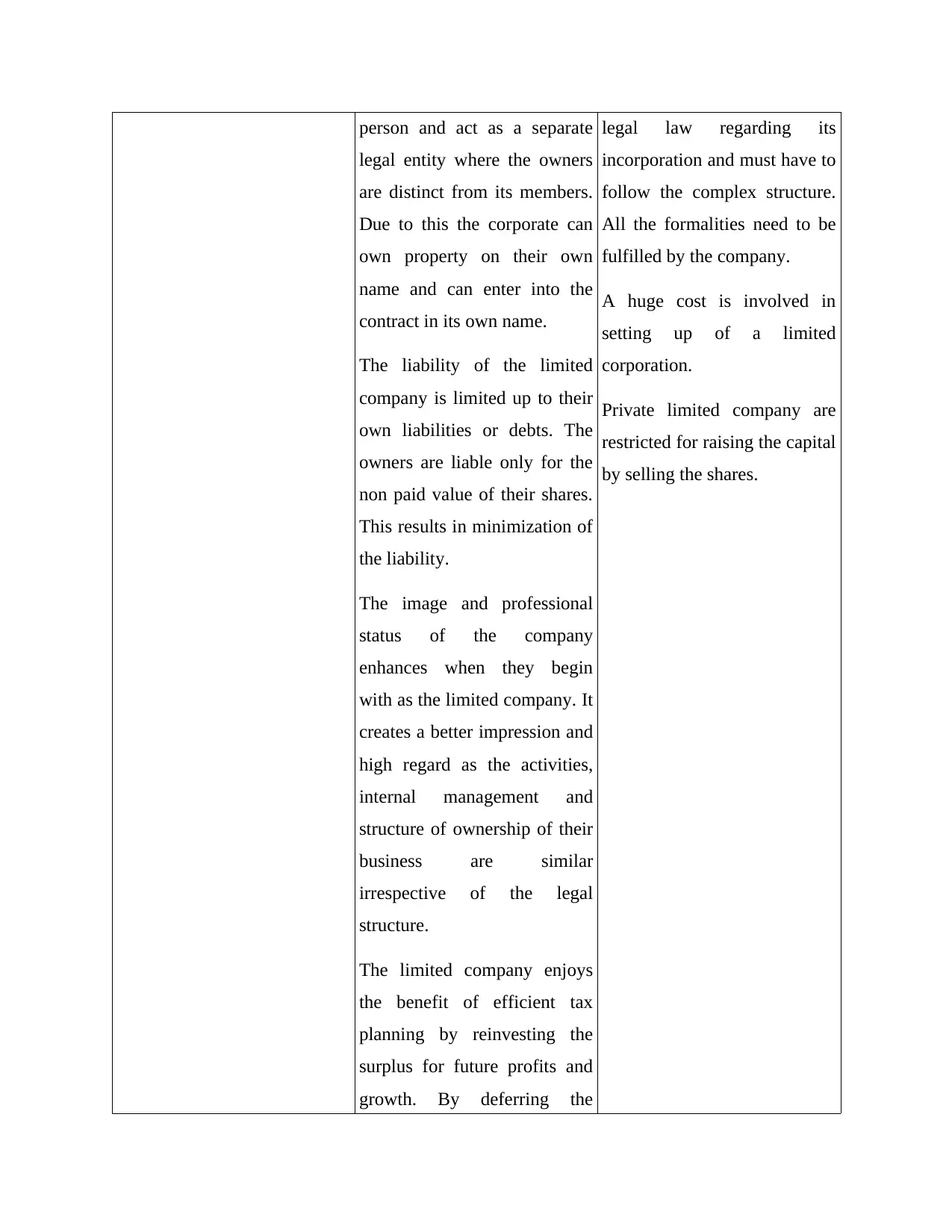
person and act as a separate
legal entity where the owners
are distinct from its members.
Due to this the corporate can
own property on their own
name and can enter into the
contract in its own name.
The liability of the limited
company is limited up to their
own liabilities or debts. The
owners are liable only for the
non paid value of their shares.
This results in minimization of
the liability.
The image and professional
status of the company
enhances when they begin
with as the limited company. It
creates a better impression and
high regard as the activities,
internal management and
structure of ownership of their
business are similar
irrespective of the legal
structure.
The limited company enjoys
the benefit of efficient tax
planning by reinvesting the
surplus for future profits and
growth. By deferring the
legal law regarding its
incorporation and must have to
follow the complex structure.
All the formalities need to be
fulfilled by the company.
A huge cost is involved in
setting up of a limited
corporation.
Private limited company are
restricted for raising the capital
by selling the shares.
legal entity where the owners
are distinct from its members.
Due to this the corporate can
own property on their own
name and can enter into the
contract in its own name.
The liability of the limited
company is limited up to their
own liabilities or debts. The
owners are liable only for the
non paid value of their shares.
This results in minimization of
the liability.
The image and professional
status of the company
enhances when they begin
with as the limited company. It
creates a better impression and
high regard as the activities,
internal management and
structure of ownership of their
business are similar
irrespective of the legal
structure.
The limited company enjoys
the benefit of efficient tax
planning by reinvesting the
surplus for future profits and
growth. By deferring the
legal law regarding its
incorporation and must have to
follow the complex structure.
All the formalities need to be
fulfilled by the company.
A huge cost is involved in
setting up of a limited
corporation.
Private limited company are
restricted for raising the capital
by selling the shares.
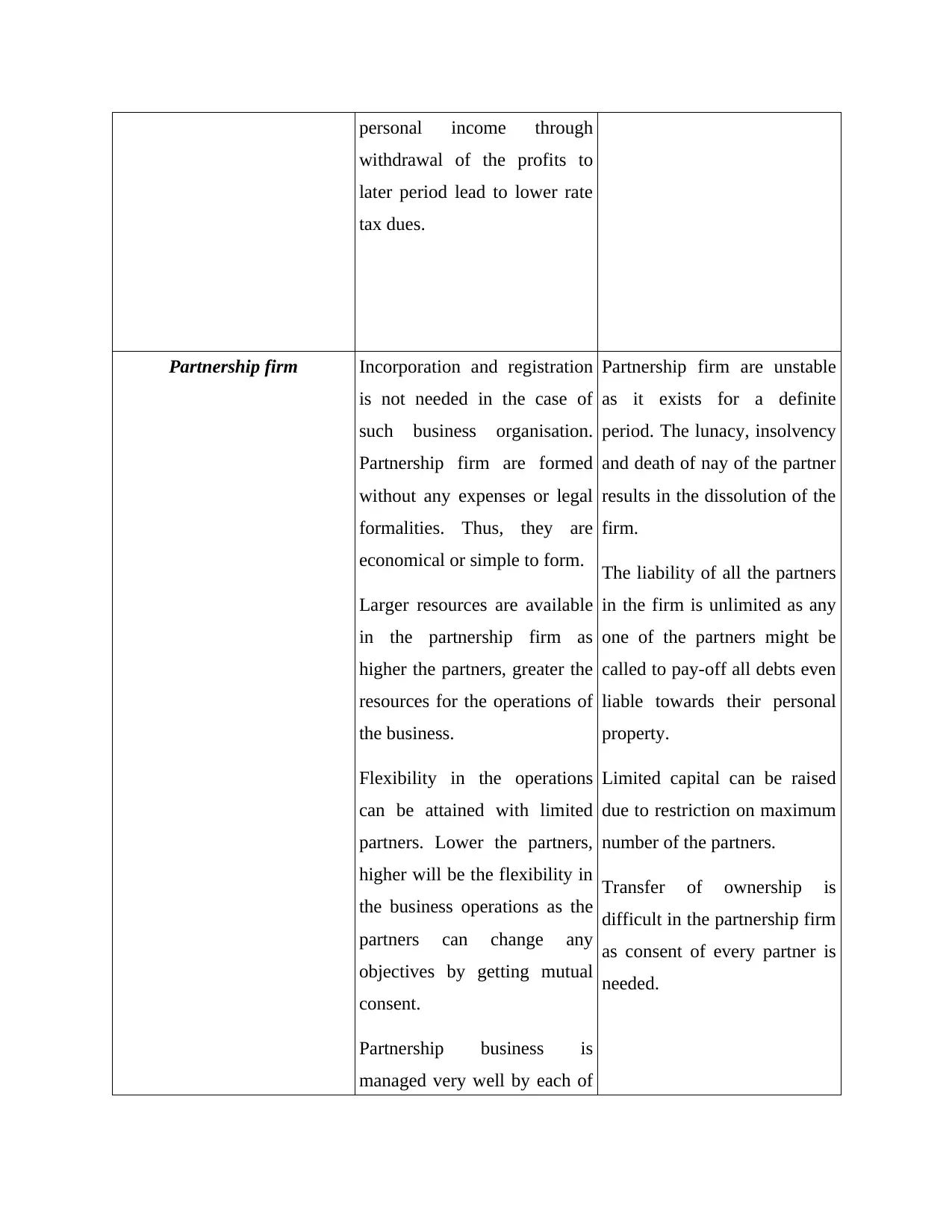
personal income through
withdrawal of the profits to
later period lead to lower rate
tax dues.
Partnership firm Incorporation and registration
is not needed in the case of
such business organisation.
Partnership firm are formed
without any expenses or legal
formalities. Thus, they are
economical or simple to form.
Larger resources are available
in the partnership firm as
higher the partners, greater the
resources for the operations of
the business.
Flexibility in the operations
can be attained with limited
partners. Lower the partners,
higher will be the flexibility in
the business operations as the
partners can change any
objectives by getting mutual
consent.
Partnership business is
managed very well by each of
Partnership firm are unstable
as it exists for a definite
period. The lunacy, insolvency
and death of nay of the partner
results in the dissolution of the
firm.
The liability of all the partners
in the firm is unlimited as any
one of the partners might be
called to pay-off all debts even
liable towards their personal
property.
Limited capital can be raised
due to restriction on maximum
number of the partners.
Transfer of ownership is
difficult in the partnership firm
as consent of every partner is
needed.
withdrawal of the profits to
later period lead to lower rate
tax dues.
Partnership firm Incorporation and registration
is not needed in the case of
such business organisation.
Partnership firm are formed
without any expenses or legal
formalities. Thus, they are
economical or simple to form.
Larger resources are available
in the partnership firm as
higher the partners, greater the
resources for the operations of
the business.
Flexibility in the operations
can be attained with limited
partners. Lower the partners,
higher will be the flexibility in
the business operations as the
partners can change any
objectives by getting mutual
consent.
Partnership business is
managed very well by each of
Partnership firm are unstable
as it exists for a definite
period. The lunacy, insolvency
and death of nay of the partner
results in the dissolution of the
firm.
The liability of all the partners
in the firm is unlimited as any
one of the partners might be
called to pay-off all debts even
liable towards their personal
property.
Limited capital can be raised
due to restriction on maximum
number of the partners.
Transfer of ownership is
difficult in the partnership firm
as consent of every partner is
needed.
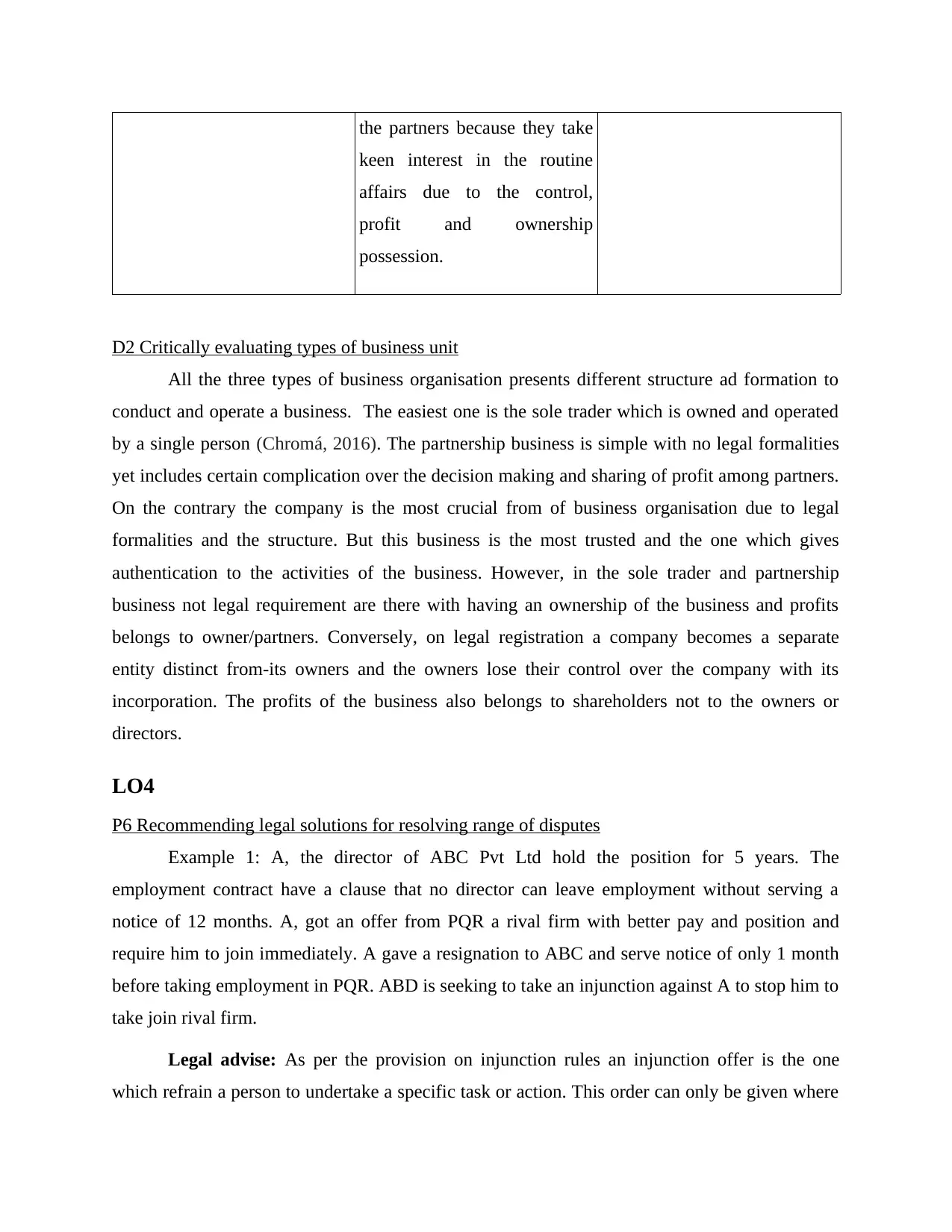
the partners because they take
keen interest in the routine
affairs due to the control,
profit and ownership
possession.
D2 Critically evaluating types of business unit
All the three types of business organisation presents different structure ad formation to
conduct and operate a business. The easiest one is the sole trader which is owned and operated
by a single person (Chromá, 2016). The partnership business is simple with no legal formalities
yet includes certain complication over the decision making and sharing of profit among partners.
On the contrary the company is the most crucial from of business organisation due to legal
formalities and the structure. But this business is the most trusted and the one which gives
authentication to the activities of the business. However, in the sole trader and partnership
business not legal requirement are there with having an ownership of the business and profits
belongs to owner/partners. Conversely, on legal registration a company becomes a separate
entity distinct from-its owners and the owners lose their control over the company with its
incorporation. The profits of the business also belongs to shareholders not to the owners or
directors.
LO4
P6 Recommending legal solutions for resolving range of disputes
Example 1: A, the director of ABC Pvt Ltd hold the position for 5 years. The
employment contract have a clause that no director can leave employment without serving a
notice of 12 months. A, got an offer from PQR a rival firm with better pay and position and
require him to join immediately. A gave a resignation to ABC and serve notice of only 1 month
before taking employment in PQR. ABD is seeking to take an injunction against A to stop him to
take join rival firm.
Legal advise: As per the provision on injunction rules an injunction offer is the one
which refrain a person to undertake a specific task or action. This order can only be given where
keen interest in the routine
affairs due to the control,
profit and ownership
possession.
D2 Critically evaluating types of business unit
All the three types of business organisation presents different structure ad formation to
conduct and operate a business. The easiest one is the sole trader which is owned and operated
by a single person (Chromá, 2016). The partnership business is simple with no legal formalities
yet includes certain complication over the decision making and sharing of profit among partners.
On the contrary the company is the most crucial from of business organisation due to legal
formalities and the structure. But this business is the most trusted and the one which gives
authentication to the activities of the business. However, in the sole trader and partnership
business not legal requirement are there with having an ownership of the business and profits
belongs to owner/partners. Conversely, on legal registration a company becomes a separate
entity distinct from-its owners and the owners lose their control over the company with its
incorporation. The profits of the business also belongs to shareholders not to the owners or
directors.
LO4
P6 Recommending legal solutions for resolving range of disputes
Example 1: A, the director of ABC Pvt Ltd hold the position for 5 years. The
employment contract have a clause that no director can leave employment without serving a
notice of 12 months. A, got an offer from PQR a rival firm with better pay and position and
require him to join immediately. A gave a resignation to ABC and serve notice of only 1 month
before taking employment in PQR. ABD is seeking to take an injunction against A to stop him to
take join rival firm.
Legal advise: As per the provision on injunction rules an injunction offer is the one
which refrain a person to undertake a specific task or action. This order can only be given where
Secure Best Marks with AI Grader
Need help grading? Try our AI Grader for instant feedback on your assignments.
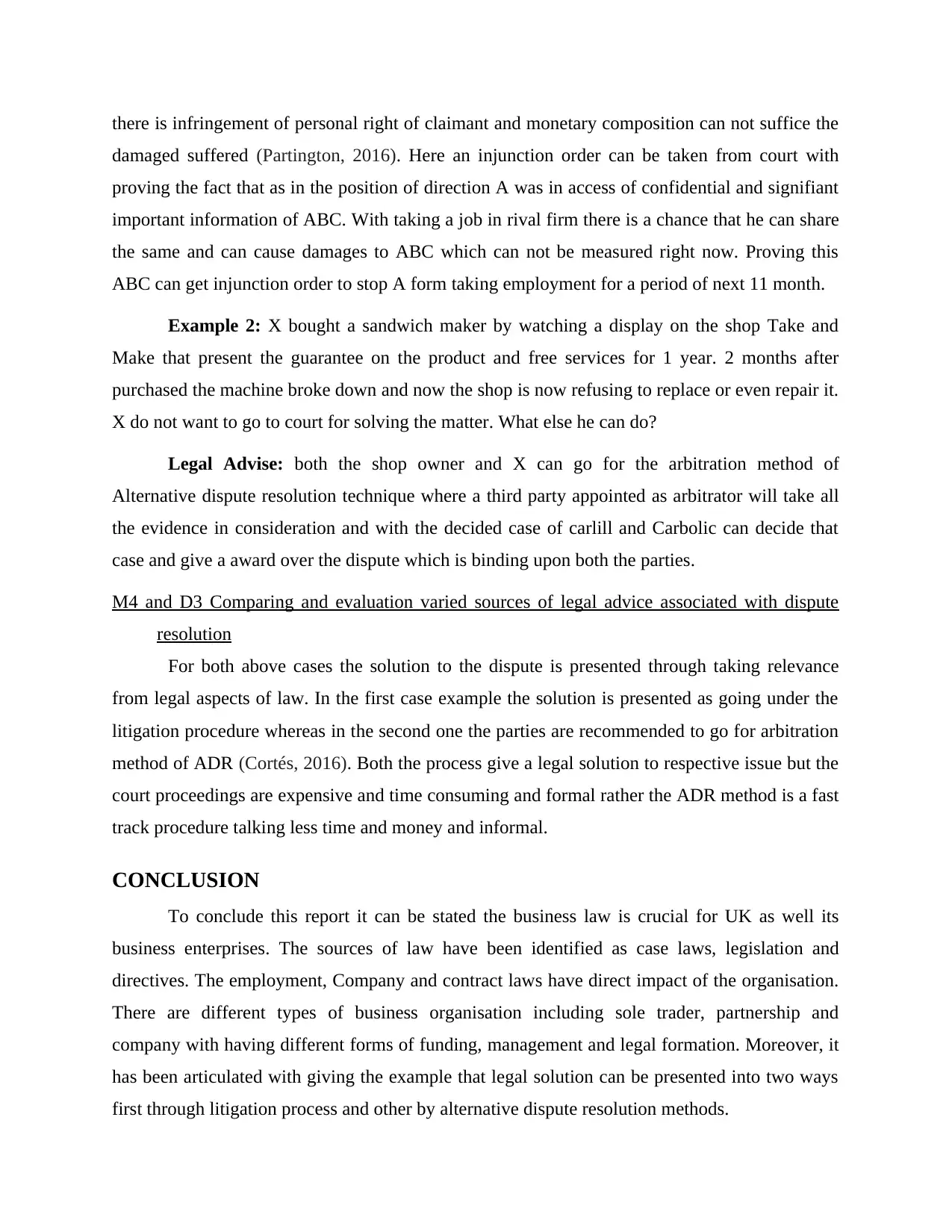
there is infringement of personal right of claimant and monetary composition can not suffice the
damaged suffered (Partington, 2016). Here an injunction order can be taken from court with
proving the fact that as in the position of direction A was in access of confidential and signifiant
important information of ABC. With taking a job in rival firm there is a chance that he can share
the same and can cause damages to ABC which can not be measured right now. Proving this
ABC can get injunction order to stop A form taking employment for a period of next 11 month.
Example 2: X bought a sandwich maker by watching a display on the shop Take and
Make that present the guarantee on the product and free services for 1 year. 2 months after
purchased the machine broke down and now the shop is now refusing to replace or even repair it.
X do not want to go to court for solving the matter. What else he can do?
Legal Advise: both the shop owner and X can go for the arbitration method of
Alternative dispute resolution technique where a third party appointed as arbitrator will take all
the evidence in consideration and with the decided case of carlill and Carbolic can decide that
case and give a award over the dispute which is binding upon both the parties.
M4 and D3 Comparing and evaluation varied sources of legal advice associated with dispute
resolution
For both above cases the solution to the dispute is presented through taking relevance
from legal aspects of law. In the first case example the solution is presented as going under the
litigation procedure whereas in the second one the parties are recommended to go for arbitration
method of ADR (Cortés, 2016). Both the process give a legal solution to respective issue but the
court proceedings are expensive and time consuming and formal rather the ADR method is a fast
track procedure talking less time and money and informal.
CONCLUSION
To conclude this report it can be stated the business law is crucial for UK as well its
business enterprises. The sources of law have been identified as case laws, legislation and
directives. The employment, Company and contract laws have direct impact of the organisation.
There are different types of business organisation including sole trader, partnership and
company with having different forms of funding, management and legal formation. Moreover, it
has been articulated with giving the example that legal solution can be presented into two ways
first through litigation process and other by alternative dispute resolution methods.
damaged suffered (Partington, 2016). Here an injunction order can be taken from court with
proving the fact that as in the position of direction A was in access of confidential and signifiant
important information of ABC. With taking a job in rival firm there is a chance that he can share
the same and can cause damages to ABC which can not be measured right now. Proving this
ABC can get injunction order to stop A form taking employment for a period of next 11 month.
Example 2: X bought a sandwich maker by watching a display on the shop Take and
Make that present the guarantee on the product and free services for 1 year. 2 months after
purchased the machine broke down and now the shop is now refusing to replace or even repair it.
X do not want to go to court for solving the matter. What else he can do?
Legal Advise: both the shop owner and X can go for the arbitration method of
Alternative dispute resolution technique where a third party appointed as arbitrator will take all
the evidence in consideration and with the decided case of carlill and Carbolic can decide that
case and give a award over the dispute which is binding upon both the parties.
M4 and D3 Comparing and evaluation varied sources of legal advice associated with dispute
resolution
For both above cases the solution to the dispute is presented through taking relevance
from legal aspects of law. In the first case example the solution is presented as going under the
litigation procedure whereas in the second one the parties are recommended to go for arbitration
method of ADR (Cortés, 2016). Both the process give a legal solution to respective issue but the
court proceedings are expensive and time consuming and formal rather the ADR method is a fast
track procedure talking less time and money and informal.
CONCLUSION
To conclude this report it can be stated the business law is crucial for UK as well its
business enterprises. The sources of law have been identified as case laws, legislation and
directives. The employment, Company and contract laws have direct impact of the organisation.
There are different types of business organisation including sole trader, partnership and
company with having different forms of funding, management and legal formation. Moreover, it
has been articulated with giving the example that legal solution can be presented into two ways
first through litigation process and other by alternative dispute resolution methods.
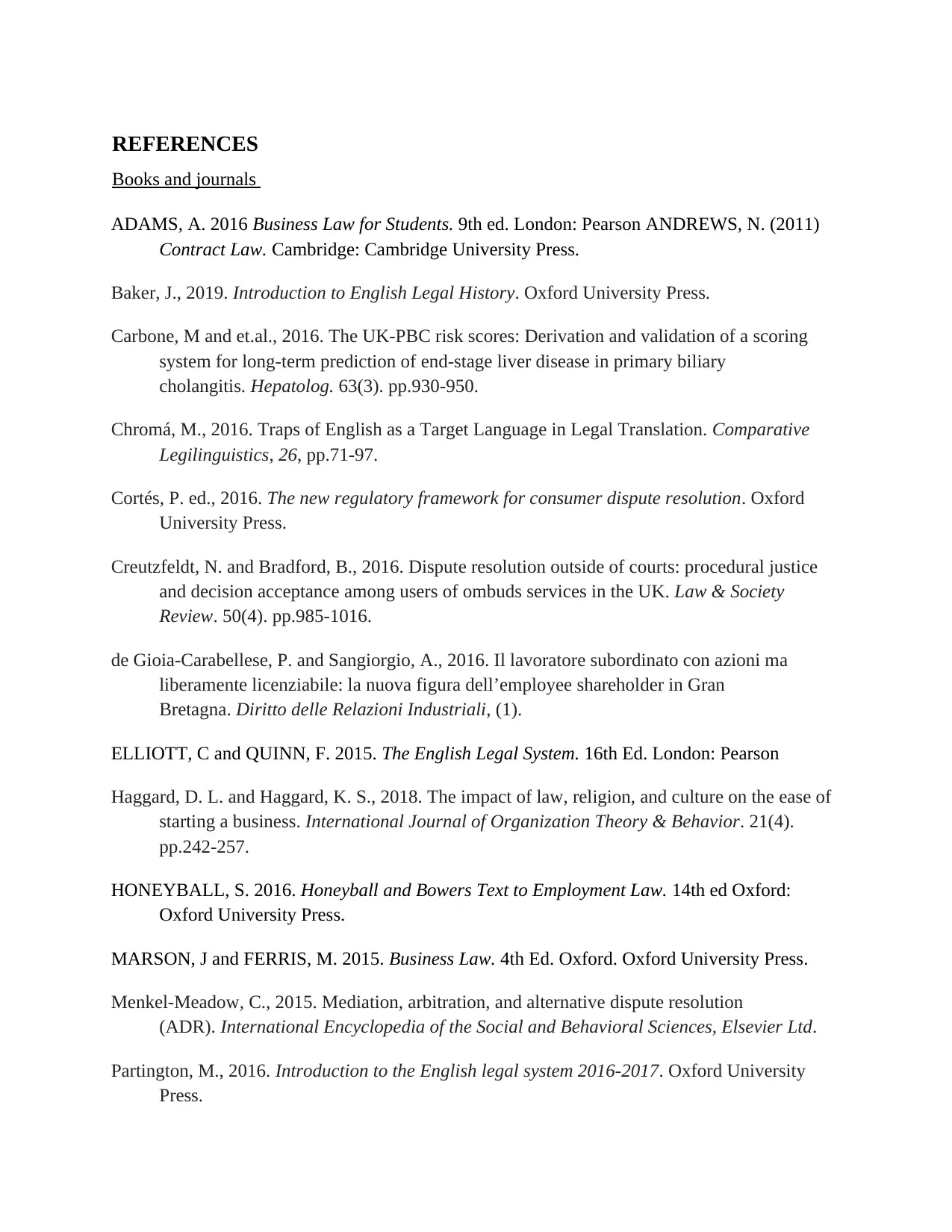
REFERENCES
Books and journals
ADAMS, A. 2016 Business Law for Students. 9th ed. London: Pearson ANDREWS, N. (2011)
Contract Law. Cambridge: Cambridge University Press.
Baker, J., 2019. Introduction to English Legal History. Oxford University Press.
Carbone, M and et.al., 2016. The UK‐PBC risk scores: Derivation and validation of a scoring
system for long‐term prediction of end‐stage liver disease in primary biliary
cholangitis. Hepatolog. 63(3). pp.930-950.
Chromá, M., 2016. Traps of English as a Target Language in Legal Translation. Comparative
Legilinguistics, 26, pp.71-97.
Cortés, P. ed., 2016. The new regulatory framework for consumer dispute resolution. Oxford
University Press.
Creutzfeldt, N. and Bradford, B., 2016. Dispute resolution outside of courts: procedural justice
and decision acceptance among users of ombuds services in the UK. Law & Society
Review. 50(4). pp.985-1016.
de Gioia-Carabellese, P. and Sangiorgio, A., 2016. Il lavoratore subordinato con azioni ma
liberamente licenziabile: la nuova figura dell’employee shareholder in Gran
Bretagna. Diritto delle Relazioni Industriali, (1).
ELLIOTT, C and QUINN, F. 2015. The English Legal System. 16th Ed. London: Pearson
Haggard, D. L. and Haggard, K. S., 2018. The impact of law, religion, and culture on the ease of
starting a business. International Journal of Organization Theory & Behavior. 21(4).
pp.242-257.
HONEYBALL, S. 2016. Honeyball and Bowers Text to Employment Law. 14th ed Oxford:
Oxford University Press.
MARSON, J and FERRIS, M. 2015. Business Law. 4th Ed. Oxford. Oxford University Press.
Menkel-Meadow, C., 2015. Mediation, arbitration, and alternative dispute resolution
(ADR). International Encyclopedia of the Social and Behavioral Sciences, Elsevier Ltd.
Partington, M., 2016. Introduction to the English legal system 2016-2017. Oxford University
Press.
Books and journals
ADAMS, A. 2016 Business Law for Students. 9th ed. London: Pearson ANDREWS, N. (2011)
Contract Law. Cambridge: Cambridge University Press.
Baker, J., 2019. Introduction to English Legal History. Oxford University Press.
Carbone, M and et.al., 2016. The UK‐PBC risk scores: Derivation and validation of a scoring
system for long‐term prediction of end‐stage liver disease in primary biliary
cholangitis. Hepatolog. 63(3). pp.930-950.
Chromá, M., 2016. Traps of English as a Target Language in Legal Translation. Comparative
Legilinguistics, 26, pp.71-97.
Cortés, P. ed., 2016. The new regulatory framework for consumer dispute resolution. Oxford
University Press.
Creutzfeldt, N. and Bradford, B., 2016. Dispute resolution outside of courts: procedural justice
and decision acceptance among users of ombuds services in the UK. Law & Society
Review. 50(4). pp.985-1016.
de Gioia-Carabellese, P. and Sangiorgio, A., 2016. Il lavoratore subordinato con azioni ma
liberamente licenziabile: la nuova figura dell’employee shareholder in Gran
Bretagna. Diritto delle Relazioni Industriali, (1).
ELLIOTT, C and QUINN, F. 2015. The English Legal System. 16th Ed. London: Pearson
Haggard, D. L. and Haggard, K. S., 2018. The impact of law, religion, and culture on the ease of
starting a business. International Journal of Organization Theory & Behavior. 21(4).
pp.242-257.
HONEYBALL, S. 2016. Honeyball and Bowers Text to Employment Law. 14th ed Oxford:
Oxford University Press.
MARSON, J and FERRIS, M. 2015. Business Law. 4th Ed. Oxford. Oxford University Press.
Menkel-Meadow, C., 2015. Mediation, arbitration, and alternative dispute resolution
(ADR). International Encyclopedia of the Social and Behavioral Sciences, Elsevier Ltd.
Partington, M., 2016. Introduction to the English legal system 2016-2017. Oxford University
Press.
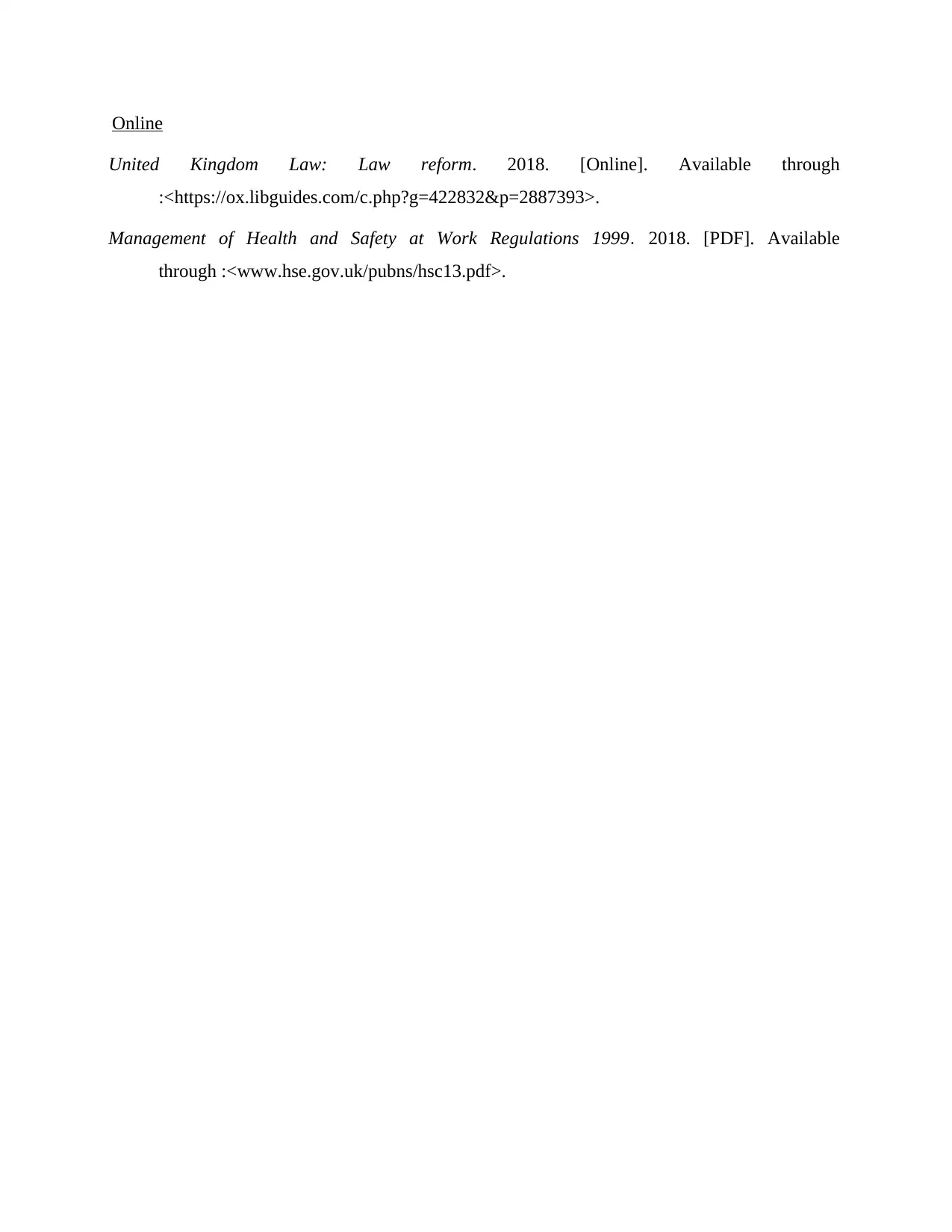
Online
United Kingdom Law: Law reform. 2018. [Online]. Available through
:<https://ox.libguides.com/c.php?g=422832&p=2887393>.
Management of Health and Safety at Work Regulations 1999. 2018. [PDF]. Available
through :<www.hse.gov.uk/pubns/hsc13.pdf>.
United Kingdom Law: Law reform. 2018. [Online]. Available through
:<https://ox.libguides.com/c.php?g=422832&p=2887393>.
Management of Health and Safety at Work Regulations 1999. 2018. [PDF]. Available
through :<www.hse.gov.uk/pubns/hsc13.pdf>.
1 out of 16
![[object Object]](/_next/static/media/star-bottom.7253800d.svg)





